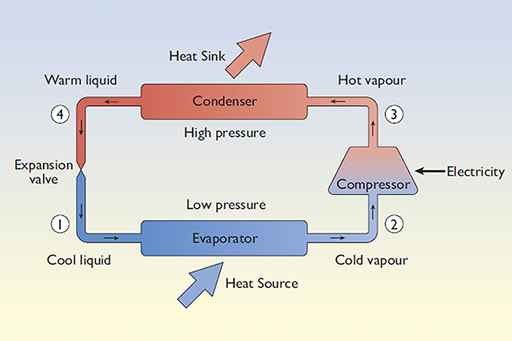8 Heat pumps
Another way of harnessing the Sun’s warmth is to use a heat pump. This works like a refrigerator, except that in countries such as the UK it is likely to be primarily used for heating rather than cooling.
Have a look at Figure 18, which shows the main elements within the most common type of heat pump.

Essentially, electricity is used to ‘pump’ heat from a low temperature in the evaporator to a higher temperature in the condenser. Here’s a more detailed description:
- a.The heat pumping process is made possible by the use of a special refrigerant liquid that boils at low temperature (about –15 °C). At point 1 in Figure 18 it starts as a cool liquid at a low pressure.
- b.In order to convert this cool liquid to a vapour, it must be given energy – the so-called latent heat of evaporation.
- c.The refrigerant absorbs heat from the heat source in a heat exchanger, called the evaporator, and it vaporizes (point 2).
- d.The vapour then enters an electrically driven compressor that raises both its pressure and temperature (point 3).
- e.The hot vapour then enters another heat exchanger, the condenser, where it condenses to a warm liquid and gives up its latent heat of evaporation (point 4).
- f.Finally the liquid is forced through a fine expansion valve where it loses pressure, vaporising and dropping in temperature.
- g.The cycle is then repeated
There are two main types of heat pump and we’ll look at these next.
